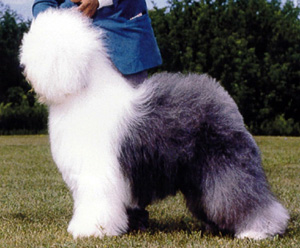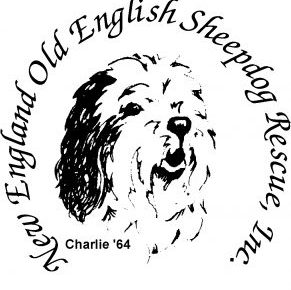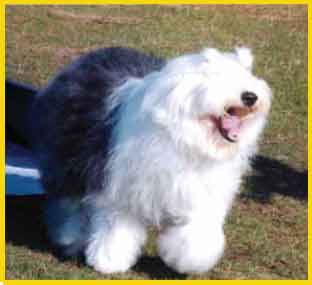The Old English Sheepdog – Then and Now
Written by Dianne McKee-Rowland for ShowSight magazine, May 2012
Today much seems to have been forgotten about the varied duties they were required for. In those earlier times a farmer could not afford to have a dog for every job and
THAT IS WHERE THE OES CAME IN WITH HIS STRONG AND FLEXIBLE STRUCTURE.
Old English Sheepdogs do not have a specific date of origin because none was recorded or those records have been lost to antiquity. Today much seems to have been forgotten about the varied duties they were required for. In those earlier times a farmer could not afford to have a dog for every job and that is where the OES came in with his strong and flexible structure. It is this anatomy that Judges of today are expected to give the same importance to as the original developers did and not simply the grooming job of talented exhibitors. The founders of our breed were dog enthusiasts who had very determined interests in the OES when it was first recognized as a separate breed, some of whom were breeder/judges. Mr. Freeman Lloyd is credited with writing the first Standard for OES in 1885. The next 20 years saw the breeding done by Mr. Edwardes Ker, in the 1880s and 1890s, further shape the breed into the OES we recognize today. The first OES Club was founded in England in 1888. Mr. Lloyd and Mr. Henry Arthur Tilley influenced the breed in the UK and the USA well into the 1950s. There is an article written by Mr. Lloyd that appears in the American Kennel Gazette in 1929 in which he describes how the desirable characteristics of the breed were determined. Thankfully early fanciers were not reticent about their feelings with regard to the size, structure, movement, coat color and coat texture and often submitted articles to the periodicals of the time in the UK. Until about 1900, OES were shown in the Collie class. At the first Collie Club of America Specialty, 3 OES males placed 1st, 2nd and 3rd in the open dog class and a female placed 4th in the open bitch class. The first OES registered in the US was the Glencho Collie kennel's Bob and he was first shown in 1885. From the beginning, they were found to have the incredible sense of humor that can be found in today's dogs.
Stout and strong are two very important words used to describe an OES.
THEY HAVE BACKPACKED WITH HIKERS AND BECAUSE OF THEIR CALM NATURE ARE OFTEN USED AS THERAPY DOGS. MORE ARE IN TRAINING AS SCENT DISCRIMINATORS AND OR MEDICAL ALERT AND SERVICE DOGS.
When you consider everything the OES has been asked to do, you will realize that their structure is of the utmost importance.
OES served in WWI, starred in movies and plays as well as performing various chores for their owners. It is his anatomy and temperament that enables him to do the many feats he might be called upon to do with or for the owners of today. One OES can be found in photographs of John Suter's team of Standard Poodles, with which he competed in the Alaskan Iditarod dog sled race.* Today some are used in recreational dog teams and for Skijoring. Thankfully there are many photographs showing OES performing all kinds of duties such as moving livestock, penning them, guarding them, pulling a cart or retrieving game birds shot for the table, which meant they had to be built for sustained efforts. Stout and strong are two very important words used to describe an OES. They have backpacked with hikers and because of their calm nature are often used as therapy dogs. More are in training as scent discriminators and or medical alert and service dogs. When you consider everything the OES has been asked to do, you will realize that their structure is of the utmost importance.
Far too often, only 20% of the dog is actually touched during the judge's examination of the dog's structure.
THE ORIGINAL BREEDERS FANCIERS, JUDGES AND FARMERS WHO ARE CREDITED WITH DEVELOPING THE BREED WERE MOST EXPLICIT ABOUT THE TOTAL DOG.
The old articles from the 1800s describe the desired coat and that was not the softer coats often found in many of today's sculptured OES. They were said to have a thick jacket of strong, hard guard hairs over a softer undercoat. The current Standard is specific about the color and texture of the coat. Few people know that the first OES came in many colors including brown, black, red and white and on very rare occasions these will still occur. Perhaps the founders should also have included a scoring system designed to let judges know how well exhibitors feel they are doing in finding the best dog for the wide range of performance they might be called upon to do. Far too often only, 20% of the dog is actually touched during the judge's examination of the dog's structure. The original breeders fanciers, judges and farmers who are credited with developing the breed were most explicit about the total dog. With the diminished numbers of dogs being shown we need to level the playing field for all exhibitors. Judges should not be intimidated by the handler who seems to hover over his/her grooming job. The Standard describes what an OES should be. It is up to judges to show the exhibitors and gallery that we have thoroughly evaluated every attribute of each dog in all classes equally, including the often ignored feet against that standard. Early mentors suggested I practice going over dogs with my eyes closed and then again with them open to further develop hand/eye coordination. The founders of our breed did not depend heavily upon the look of the animal, but on its ability to do the job they were being sought for and that meant structure.
It is up to judges to show the exhibitors and gallery
THAT WE HAVE THOROUGHLY EVALUATED EVERY ATTRIBUTE OF EACH DOG IN ALL CLASSES EQUALLY
including the often ignored feet against that standard.
The OES is one of a fair number of breeds that are found in almost all performance competitions. It is their structure that enables them to do this well. On a personal level I hope we will get back to a point where less dependence is placed upon the sculpting of the OES coat and more of our dogs will be allowed to have some fun in the original working and newer performance events. When I watch a class of OES being judged I often think, "Will the real OES please step forward." There are several excellent books and articles written by both breeders and fanciers that detail the OES from their obscure beginnings up to modern times. All authors brought their own insight into what is a breed of many talents. Many of these writings are still available (although they might not be first editions) and the parent club for OES has many excellent mentors as well.








